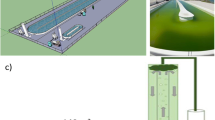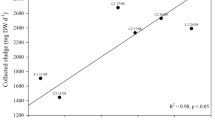Abstract
This project investigated the feasibility of using sewage sludge to culture microalgae (Chlorella-HKBU) and their subsequent usage as feeds for rearing different organisms. Part II of the project evaluated the results of applying the sludge-grown algae to feedOreochromis mossambicus (fish),Macrobrachium hainenese (shrimp), andMoina macrocopa (cladocera). In general, the yields of the cultivated organisms were unsatisfactory when they were fed the sludge-grown algae directly. The body weights ofO. mossambicus andM. macrocopa dropped 21% and 37%, respectively, although there was a slight increase (4.4%) inM. hainenese. However, when feeding the algal-fed cladocerans to fish and shrimp, the body weights of the fish and shrimp were increased 7% and 11% accordingly. Protein contents of the cultivated organisms were comparable to the control diet, although they contained a rather high amount of heavy metals. When comparing absolute heavy metal contents in the cultivated organisms, the following order was observed: alga > cladocera > shrimp, fish > sludge extracts. Bioelimination of heavy metals may account for the decreasing heavy metal concentrations in higher trophic organisms.
Similar content being viewed by others
Literature Cited
Allen, S. E. (ed.). 1989. Chemical analysis of ecological materials. Blackwell, Oxford.
Amiard-Triquet, C. 1979. Modalités de la contamination de deux chaines trophiques dulcaquicoles par le cobalt 60: III. Contamination des organisms par l'intermediaire de la nourriture.Water, Air and Soil Pollution 5:230–237.
Amiard-Triquet, C. and A. Saas. 1979. Modalités de la contamination de deux chaines trophiques dulcaquicoles par le cobalt 60: II. Contamination simulanée des organisms per l'eau.Water, Air and Soil Pollution 5:221–229.
Atack, T. H., K. Jauncy, and A. J. Matty. 1979. The utilization of some single cell proteins by fingerling mirror carp. (Cyprinus carpio).Aquaculture 18:337–348.
Becker, E. W. 1989. Nutritional properties of microalgae: Potentials and constraints. Pages 245–263in A. Richmond (ed.), Handbook of microalgal mass culture. CRC Press, Boca Raton, Florida.
Bertine, K. K., and E. O. Goldberg. 1972. Trace elements in clams, mussels and shrimps.Limnology and Oceanography 17:877–884.
Bogatova, I. B., M. A. Shchesbina, V. V. Ovinnikova, and N. A. Tagesova. 1973. The chemical composition of certain planktonic animal under different growing conditions.Hydrobiological Journal 7:39–43.
Chernoff, B., and J. H. Dolley. 1979. Heavy metals in relation to the biology of the mummuhig,Fundulus heteroclitus.Journal of Fisheries and Biology 14:309–328.
Dethlefsen, W. 1978. Uptake, retention and loss of Cd by brown shrimp (Crangon crangon).Meersforch 26:137–154.
Duedall, I. W., H. B. O'Connors, and B. Irwin. 1975. Fate of wastewater sludge in the New York Bight Apex.Journal of the Water Pollution Control Federation, 47:2702–2706.
Flis, J. 1968. Anatomicrohistopathological changes induced in carp (Cyprinus carpio L.) by ammonia water. Part I. Effect of toxic concentration.Acta Hydrobiologie 10:205–234.
Garrett, M. K., and M. D. B. Allen. 1976. Photosynthetic purification the liquid phase of animal slurry.Environmental Pollution 5:127–139.
Goldman, J. C. 1979. Outdoor algal mass culture. I: Applications.Water Research 13:1–19.
Goldman, J. C. and J. H. Ryther. 1975. Mass production of marine algae in outdoor culture.Nature 254:594–595.
Hall, T. M. 1982. Free ionic nickel accumulation and localization in freshwater zooplankton,Daphnia magna.Limnology and Oceanography 27(4):718–727.
Kaplan, D., A. E. Richmond, D. Dubinsky, and S. Aaronson. 1986. Algal nutrition. Pages 147–198in D. Kaplan (ed.), Handbook of microalgal mass culture. CRC Press, New York.
Kavanagh, B. V., P. Moodis, and L. S. Herbert. 1982. Biological sludges as animal feed supplements—analysis and composition of sludge.Agricultural Wastes 4:305–312.
Kawai, H., V. M. Grieco, and P. Jureidini. 1984. A study of the treatability of pollutants in high rate photosynthetic ponds and the utilization of the proteic potential of algae which proliferate in the ponds.Environmental Technological Letters 5:505–516.
Lowry, O. H., N. J. Rosebrough, A. L. Farr, and R. J. Randall. 1951. Protein measurement with the Folin phenol reagent.Journal of Biological Chemistry 193:265–275.
Marias, J., and T. Erasmius. 1977. Chemical composition of alimentary canals of mullets.Aquaculture 10:263–273.
Matusiak, K., M. Pryztocka-Jusiak, K. Leozczynska-Gerula, and M. Horoch. 1976. Studies on the purification of wastewater from the nitrogen fertilizer industry by intensive algal culture.Acta Microbiology Pollution 25:361–374.
Oswald, W. J., and C. G. Golueke. 1968. Large scale production of algae. Pages 271–305in R. I. Mateles and S. R. Tannenbaum (eds.), Single cell protein. Massachusetts Institute of Technology Press, Cambridge.
Oswald, W. J., E. W. Lee, B. Adams, and K. H. Yao. 1978. New wastewater treatment method yields a harvest of saleable algae.World Health Organization Chronicle 32(9):348–350.
Przytocka-Jusiak, M., M. Duszota, K. Matusiak, and R. Myselski. 1984. Intensive culture ofChlorella vulgaris of nitrogen industry wastewater.Water Research 18:1–7.
Shelef, G., I. Oron, and R. Moraine. 1978. Economic aspects of micro-algae production on sewage.Archiv für Hydrobiologie 100:207–218.
Sin, W. C. A., and T. L. M. Chiu. 1982. Summer and winter kills in fish ponds of Hong Kong and their possible prediction.Aquaculture 29:125–135.
Tacon, A. G. J. and S. S. Ferns. 1983. Use of activated sludge from domestic sewage in trout diets.Nutrition Reports International 13:549–562.
Tarifeno-Silva, E., L. Y. Kawasaki, L. P. Yu, and M. S. Gordon. 1982a. Aquacultural approaches to recycling of nutrient dissolved nutrients in secondarily treated domestic wastewater—II Biological productivity of artificial food chains.Water Research 16:51–57.
Tarifeno-Silva, E., L. Y. Kawasaki, L. P. Yu, and M. S. Gordon. 1982b. Aquacultural approaches to recycling of nutrient dissolved nutrients in secondarily treated domestic wastewater—III. Update of dissolved heavy metals by artificial food chains.Water Research 16:59–65.
Taub, F. B., and A. M. Dollar. 1968. The nutritional inadequacy ofChlorella andChlamydomonas as food forDaphnia pulex.Limnology and Oceanography 13:607–617.
Vriens, L., R. Nihoul, and H. Verachtert. 1989. Activated sludges as animal feed: A review.Biological Wastes 27:196–207.
Wohlfarth, G. W. and G. L. Schroeder. 1979. Use of manure in fish farming—a review.Agricultural Wastes 1:279–299.
Wong, M. H. 1989. Utilisation of waste-grown algae for feeding freshwater shrimps.Resources, Conservation and Recycling 2:199–210.
Wong, M. H., and S. P. Cheung. 1980. Sewage sludge and carrot wastes as supplementary feed for the common carp,Cyprinus carpio.Environmental Pollution 23:29–39.
Wong, M. H. and Y. H. Cheung. 1985. Heavy metal contents of Macrobrachium hainenese fed with waste-grownChlorella pyrenoidosa.Agricultural Wastes 14:63–74.
Wong, M. H., and S. T. Chiu. 1993. Feasibility studies on the use of sewage sludge as supplementary feed for rearing tilapia. I. Trace metal contents of the treated fish.Environmental Technology 14:1155–1162.
Wong, M. H., and S. H. Kwan. 1981. The uptake of zinc, lead, copper and manganese by carp fed with activated sludge.Toxicology Letters 7:367–372.
Wong, M. H., and F. Y. Tam. 1984. Sewage sludge for cultivating algae and the fate of heavy metals at higher trophic organisms IV. Heavy metal contents in different trophic level.Archiv für Hydrobiologie 100:423–430.
Author information
Authors and Affiliations
Rights and permissions
About this article
Cite this article
Wong, M.H., Hung, K.M. & Chiu, S.T. Sludge-grown algae for culturing aquatic organisms: Part II. Sludge-grown algae as feeds for aquatic organisms. Environmental Management 20, 375–384 (1996). https://doi.org/10.1007/BF01203845
Issue Date:
DOI: https://doi.org/10.1007/BF01203845




